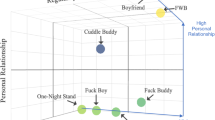Abstract
Partner concurrency (i.e., overlapping sexual partnerships) facilitates the spread of STDs, including HIV. The present study explored the context of and motivations for partner concurrency among patients recruited from an urban STD clinic. Eight focus groups were conducted with 59 patients (47% women; 77% African American). Qualitative analyses revealed five motivational themes related to the occurrence of concurrent partnerships for men and women. Participants reported these partnerships tend to occur: when people believe that sexual partners are unfaithful or cannot be trusted; when sexual satisfaction is low; when patients report the need for different partners to fulfill multiple needs; in retaliation for a partner’s concurrency; and when people wish to maintain a sexual relationship with an ex-partner who is the parent of a shared child. Four additional themes unique to men were identified. Men reported that they had multiple partners because this practice supports their sense of masculinity and is consistent with familial modeling and community norms, and because having multiple partners is “in a man’s nature.” Men also mentioned that the imbalance in the number of women-to-men in their sexual network facilitates partner concurrency. These findings can help prevention practitioners and researchers to develop interventions to reduce risk associated with partner concurrency.
Similar content being viewed by others
References
Adimora, A. A., & Schoenbach, V. J. (2005). Social context, sexual networks, and racial disparities in rates of sexually transmitted infections. Journal of Infectious Diseases, 191, S115–S122.
Adimora, A. A., Schoenbach, V. J., Bonas, D. M., Martinson, F. E. A., Donaldson, K. H., & Stancil, T. R. (2002). Concurrent sexual partnerships among women in the United States. Epidemiology, 13, 320–327.
Adimora, A. A., Schoenbach, V. J., & Doherty, I. A. (2007). Concurrent sexual partnerships among men in the United States. American Journal of Public Health, 97, 2230–2237.
Aral, S. O., Adimora, A. A., & Fenton, K. A. (2008). Understanding and responding to disparities in HIV and other sexually transmitted infections in African Americans. Lancet, 372, 337–340.
Buss, D. M. (2003). The evolution of desire: Strategies of human mating. New York: Free Press.
Carey, M. P., Senn, T. E., Seward, D. X., & Vanable, P. A. (2010). Urban African-American men speak out on sexual partner concurrency: Findings from a qualitative study. AIDS and Behavior, 14, 38–47.
Crawford, M., & Popp, D. (2003). Sexual double standards: A review and methodological critique of two decades of research. Journal of Sex Research, 40, 13–26.
Drigotas, S. M., & Rusbult, C. E. (1999). Level of commitment, mutuality of commitment, and couple well-being. Personal Relationships, 6, 389–409.
Drumright, L. N., Gorbach, P. M., & Holmes, K. K. (2004). Do people really know their sex partners? Concurrency, knowledge of partner behavior, and sexually transmitted infections within partnerships. Sexually Transmitted Diseases, 31, 437–442.
Epstein, H. (2007). The invisible cure: Africa, the West, and the fight against AIDS. New York: Farrar, Straus, & Giroux.
Epstein, H. (2010). The mathematics of concurrent partnerships and HIV: A commentary on Lurie and Rosenthal, 2009. AIDS and Behavior, 14, 29–30.
Glaser, B. G., & Strauss, A. L. (1967). The discovery of grounded theory: Strategies for qualitative research. Chicago: Aldine.
Gorbach, P. M., Stoner, B. P., Aral, S. O., Whittington, W. L. H., & Holmes, K. K. (2002). “It takes a village”: Understanding concurrent sexual partnerships in Seattle, Washington. Sexually Transmitted Diseases, 29, 453–462.
Harrison, A., Cleland, J., & Frohlich, J. (2008). Young people’s sexual partnerships in KwaZulu-Natal, South Africa: Patterns, contextual influences, and HIV risk. Studies in Family Planning, 39, 295–308.
Hill, C. A., & Preston, L. K. (1996). Individual differences in the experience of sexual motivation: Theory and measurement of dispositional sexual motives. Journal of Sex Research, 33, 27–45.
Holt-Lunstad, J., Birmingham, W., & Jones, B. Q. (2008). Is there something unique about marriage? The relative impact of marital status, relationship quality, and network social support on ambulatory blood pressure and mental health. Annals of Behavioral Medicine, 35, 239–244.
Kerrigan, D., Andrinopoulos, K., Johnson, R., Parham, P., Thomas, T., & Ellen, J. M. (2007). Staying strong: Gender ideologies among African-American adolescents and implications for HIV/STI prevention. Journal of Sex Research, 44, 172–180.
Kiecolt-Glaser, J. K., & Newton, T. L. (2001). Marriage and health: His and hers. Psychological Bulletin, 127, 472–503.
Koumans, E. H., Farley, T. A., Gibson, J. J., Langley, C., Ross, M. W., McFarlane, M., et al. (2001). Characteristics of persons with syphilis in areas of persisting syphilis in the United States: Sustained transmission associated with concurrent partnerships. Sexually Transmitted Diseases, 28, 497–503.
Kraut-Becher, J., Eisenberg, M., Voytek, C., Brown, T., Metzger, D., & Aral, S. (2008). Examining racial disparities in HIV: Lessons from sexually transmitted infections research. Journal of Acquired Immune Deficiency Syndromes, 47, S20–S27.
Lane, S. D., Rubinstein, R. A., Keefe, R. H., Webster, N., Cibula, D. A., Rosenthal, A., et al. (2004). Structural violence and racial disparity in HIV transmission. Journal of Health Care for the Poor and Underserved, 15, 319–335.
Leclerc-Madlala, S. (2003). Transactional sex and the pursuit of modernity. Social Dynamics, 29, 213–233.
Mah, T. L., & Halperin, D. T. (2010). Concurrent sexual partnerships and the HIV epidemics in Africa: Evidence to move forward. AIDS and Behavior, 14, 11–16.
Meston, C. M., & Buss, D. M. (2007). Why humans have sex. Archives of Sexual Behavior, 36, 477–507.
Miller, W. R., & Rollnick, S. (2002). Motivational interviewing: Preparing people for change (2nd ed.). New York: Guliford Press.
Morris, M. (2001). Concurrent partnerships and syphilis persistence: New thoughts on an old puzzle. Sexually Transmitted Diseases, 28, 504–507.
Morris, M., & Kretzschmar, M. (1995). Concurrent partnerships and transmission dynamics in networks. Social Networks, 17, 299–318.
Morris, M., Kurth, A. E., Hamilton, D. T., Moody, J., & Wakefield, S. (2009). Concurrent partnerships and HIV prevalence disparities by race: Linking science and public health practice. American Journal of Public Health, 99, 1023–1031.
Nelson, L. E., & Morrison-Beedy, D. (2008). Sex partner type and condom use in African American adolescent mothers: A literature review. Journal of Child and Adolescent Psychiatric Nursing, 21, 213–219.
Pilcher, C. D., Tien, H. C., Eron, J. J., Vernazza, P. L., Szu-Yun, L., Stewart, P. W., et al. (2004). Brief but efficient: Acute HIV infection and the sexual transmission of HIV. Journal of Infectious Diseases, 189, 1785–1792.
Potterat, J. J., Zimmerman-Rogers, H., Muth, S. Q., Rothenberg, R. B., Green, D. L., Taylor, J. E., et al. (1999). Chlamydia transmission: Concurrency, reproduction number, and the epidemic trajectory. American Journal of Epidemiology, 150, 1331–1339.
Ryan, R. M., & Deci, E. L. (2000). Self-determination theory and the facilitation of intrinsic motivation, social development, and well-being. American Psychologist, 55, 68–78.
Selikow, T., Zulu, B., & Cedras, E. (2002). The ingagara, the regte and the cherry: HIV/AIDS and youth culture in contemporary urban townships. Agenda, 53, 22–32.
Senn, T. E., Carey, M. P., Vanable, P. A., Coury-Doniger, P., & Urban, M. A. (2009). Sexual partner concurrency among STI clinic patients with a steady partner: Correlates and associations with condom use. Sexually Transmitted Infections, 85, 343–347.
Singer, M. C., Erickson, P. I., Badiane, L., Diaz, R., Ortiz, D., Abraham, T., et al. (2006). Syndemics, sex, and the city: Understanding sexually transmitted diseases in social and cultural context. Social Science and Medicine, 63, 2010–2021.
Watts, C. H., & May, R. M. (1992). The influence of concurrent partnerships on the dynamics of HIV/AIDS. Mathematical Biosciences, 108, 89–104.
Whaley, A. L. (2001). Cultural mistrust: An important psychological construct for diagnosis and treatment of African Americans. Professional Psychology: Research and Practice, 32, 555–562.
Whitehead, T. L. (1997). Urban, low-income African American men, HIV/AIDS, and gender identity. Medical Anthropology Quarterly, 11, 411–447.
Acknowledgments
The authors thank the participants for their contributions to this research; Rahsaan DeLain, Mary Grady, Elise Kogut; the Monroe County Health Department; and the NIMH for their support of this research (grant # 2 R01-MH068171 to Michael P. Carey, Principal Investigator).
Author information
Authors and Affiliations
Corresponding author
Rights and permissions
About this article
Cite this article
Senn, T.E., Scott-Sheldon, L.A.J., Seward, D.X. et al. Sexual Partner Concurrency of Urban Male and Female STD Clinic Patients: A Qualitative Study. Arch Sex Behav 40, 775–784 (2011). https://doi.org/10.1007/s10508-010-9688-y
Received:
Revised:
Accepted:
Published:
Issue Date:
DOI: https://doi.org/10.1007/s10508-010-9688-y




